Contents
Market Overview
Macro Review
Another blow for “team transitory”. Last week Russia surprised markets by hiking its policy rate 75bp to 7.5%, as it overtook Brazil (6.25%). Brazil reclaimed this on Wednesday by hiking 150bp, which was the largest incremental hike by the BCB in nearly 20 years (policy rate now 7.75%). The inflation pressure cooker is clearly spilling over to CEE and LATAM economies, while Asia has yet to react (other than South Korea). The next leg of the argument comes with surprise G10 inflation prints and notably with Australia as its higher-than-expected CPI print sent the ACGB 3yr up to 0.81% when the RBA target 0.1% via Yield Curve Control. On top of that, a hawkish Bank of Canada added further venom to the sell-off with an abrupt end to QE (2yr widened 13bp). The brief respite from the UK Autumn Budget saw U.S. Treasuries rally 5-7bp as Gilts tightened 8-13bp, but this was short-lived and even an ever-dovish ECB did not stop European rates pushing wider. Meanwhile, the S&P and Dow Jones made fresh new highs as Tesla’s market capitalization rose above $1tn, only to be set back by weaker earnings from Amazon, Microsoft and Facebook (“Meta”). Markets were also unperturbed by the Atlanta GDP, now falling to as low as 0.2%, which was north of 6% only in August. The VIX at one point was below 15, which reflects a pandemic low, although U.S. Treasury volatility remains elevated and above 65 (measured by the MOVE Index). Most are still focused on the significant 5s30s flattening of the U.S. Treasury curve, but 10s30s is now inside of 40bp. For EM investors it was difficult to escape the volatility within the Chinese property sector, but the NDRC consultation offered some positive tailwinds. This included five requirements: (1) registering offshore bond issuance; (2) opening channels for remittance of onshore funds to finance offshore debt; (3) continual focus to improve offshore capital structures; (4) use of proceeds should always be used only for stated purposes; and (5) property companies should proactively prepare for timely repayment. The reaction in the property sector was positive and upbeat, which was a necessary signal from the authorities. In fact, Evergrande paid the September 29th coupon just 24 hours before the end of the 30 day grace period and staves off technical default once again.
EM Credit Update
EM Credit ended the week up 0.7% as U.S. Treasuries bear flattened with the long-end rallying as 10s30s touch 36bp (2.5yr low). Suriname, Sri Lanka and Tunisia outperformed, while Ethiopia, Slovakia and Ecuador lagged. Aside from the relief rallies in Turkey and Brazil, Russian FX was in focus after the 75bp interest rate hike on October 22nd which strengthened RUB, yet the inflation print on October 27th caused significantly volatility in the OFZ local market. This is another episode of an EM central bank struggling to get ahead of the inflation wave. We note that the Russian local OFZ curve on a 2s10s basis has now inverted (-40bp), with 2yr rates now 120bp wider in October alone.
The Week Ahead
Next week the overriding focus will rest with the FOMC, BOE, Norges and RBA. One of the four has already hiked, but the BOE is set to be the second. The Bank of England would then become the third G10 central bank to hike after Norway’s Norges and New Zealand’s RBNZ. However, before these events we will have Chinese NBS and Caixin PMIs, along with trade data. Thereafter EM rate decisions are due out of Poland (0.5%), Czech Republic (1.5%) and Malaysia (1.75%), with the former two expected to hike 25bp and 50bp, respectively. Inflation dominates with Colombia, Peru, Philippines, South Korea, Taiwan, Thailand and Turkey. Beyond that, we will have two GDP releases of notes out of Hong Kong and Indonesia. Then, Brazil’s COPOM minutes ought to offer a further interlude into the Selic hiking cycle, perhaps with a further hint of where the higher terminal rate will stabilize.
Highlights from emerging markets discussed below include: The Central Bank of Brazil (BCB) continues monetary policy tightening as looming higher fiscal spending and political risks in 2022 threaten the macro outlook; and Mexico economic activity disappointed, potentially complicating the policy backdrop.
Fixed Income
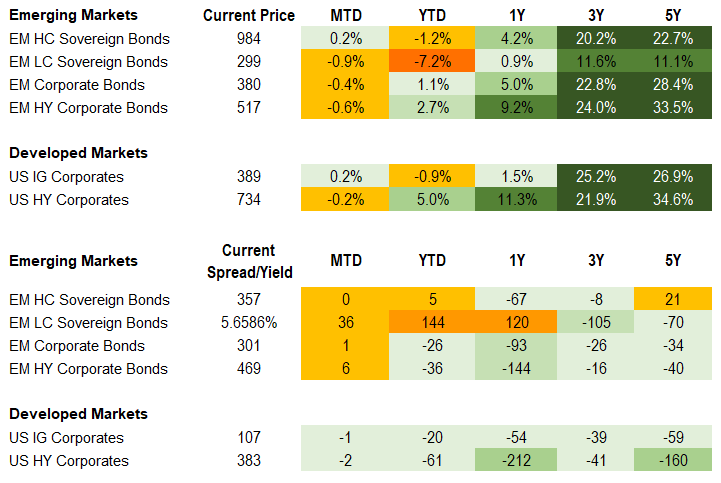
Equities
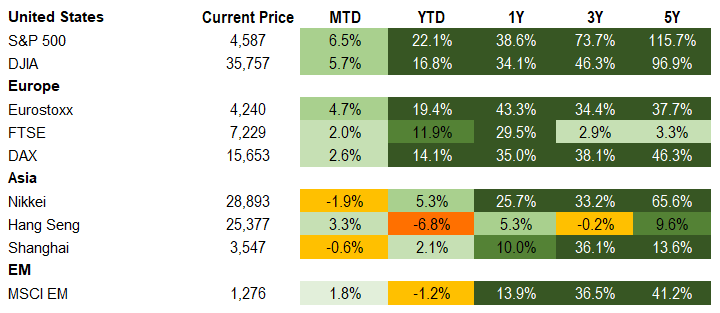
Commodities

Source for data tables: Bloomberg, JPMorgan, Gramercy. EM Fixed Income is represented by the following JPMorgan Indicies: EMBI Global, GBI-EM Global Diversified, CEMBI Broad Diversified and CEMBI Broad High Yield. DM Fixed Income is represented by the JPMorgan JULI Total Return Index and Domestic High Yield Index. Fixed Income, Equity and Commodity data is as of October 29, 2021 (mid-afternoon).
Emerging Markets Weekly Highlights
The Central Bank of Brazil (BCB) continues monetary policy tightening as looming higher fiscal spending and political risks in 2022 threaten the macro outlook
Event: The COPOM, BCB’s Monetary Policy Committee, hiked Brazil’s main policy rate (SELIC) by 150bps to 7.75% and signaled that a similar increase will be forthcoming in December.
Gramercy Commentary: The rate hike was the sixth consecutive increase delivered by the BCB this year, accelerating the pace of tightening to 150bps, from 100 bps last month. This brings the total monetary policy tightening to 575bps since March. A majority of analysts now predict a terminal SELIC rate of 10-11% in this cycle, slightly above projected 2021 year-end inflation of around 9.5%. All else being equal, headline inflation is forecasted to decelerate materially to 4-5% in 2022, which could allow the BCB to start easing policy next year and support the economy amid likely elevated political uncertainty ahead of the October presidential and general elections. Meanwhile, the Central Bank cautioned markets about a “worse balance of risks” in the short-term domestic macro environment stemming from increased pressure on Brazil’s already stretched fiscal framework. As for external factors, the BCB noted that the global environment is also “becoming less favorable” for emerging markets (EM) as monetary policy in developed markets (DM) responds to inflation that appears more persistent than previously expected. In this context, we see BCB’s decisive policy action as an attempt to offset further increases in fiscal spending that the political wing of the Bolsonaro Administration is pushing for in Congress, hoping to boost the President’s re-election chances in 2022. The emergence of a competitive centrist market-friendly presidential candidate continues to carry a low probability in our view, suggesting that investors should prepare for a vicious political fight between embattled far-right President Bolsonaro and former President and leftist icon Lula, who leads early polls by a large margin. As such, elevated economic policy uncertainty and additional erosion of already limited fiscal space are likely to continue to pressure Brazil’s FX and sovereign assets, in our view. While we do not expect an imminent and/or abrupt loss of investor confidence, we caution that markets could get incrementally more concerned about a major structural policy shift in the event Lula solidifies his position to win next year’s presidential elections.
Mexico economic activity disappointed, potentially complicating the policy backdrop
Event: The economic activity index contracted in sequential terms by 1.6% m/m in August compared to an expected expansion of 0.2% m/m led by softness in services amid COVID-19 case acceleration as well as industrial output amid supply side challenges.
Gramercy Commentary: If weakness persists, policy challenges will arise in the backdrop of sticky inflation and U.S. normalization on the monetary front and weaker revenues on the fiscal side. This likely softens the near-term debate over prospects for more aggressive 50bps vs. 25bps hikes through year-end and lends support to a more dovish approach under new leadership in the new year. However, given the nature of the price pressures, it is unlikely in our view that these abate materially in the near-term. While we do not anticipate energy legislation to pass in its current state, the broader approach to the sector and micro-level policy should continue to pose headwinds to the medium-term recovery of investment and growth.
Emerging Markets Technicals
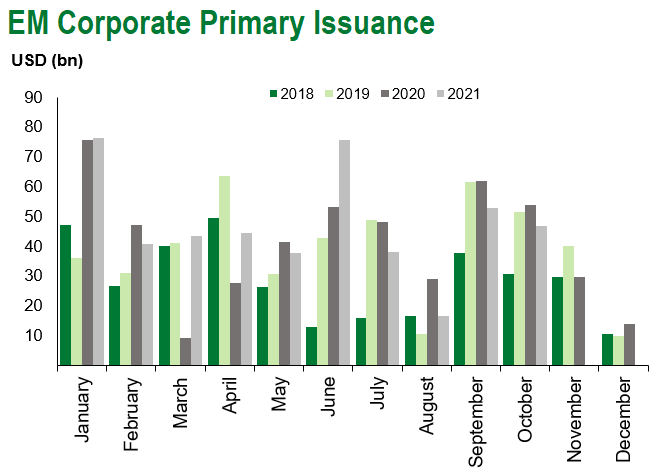
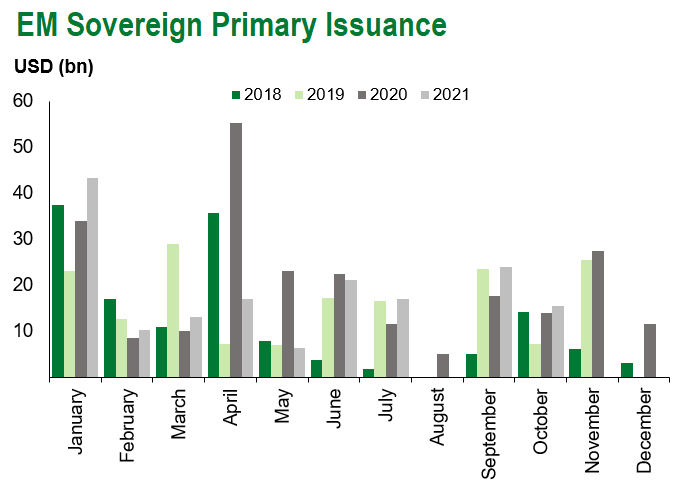
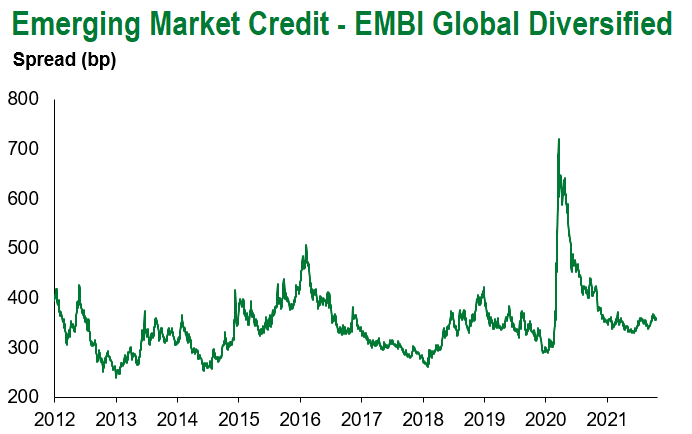
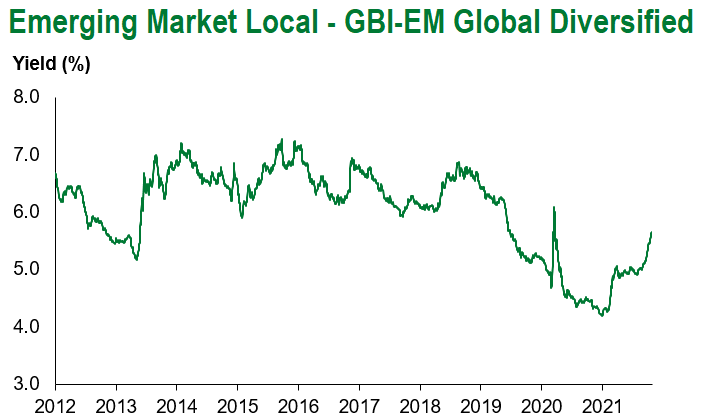
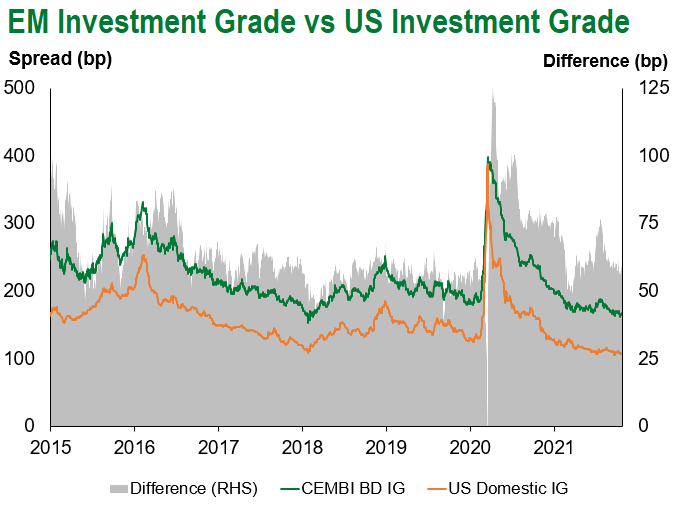
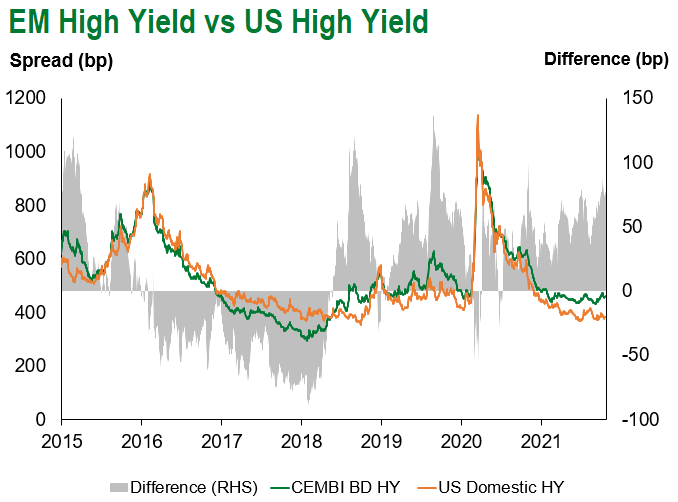
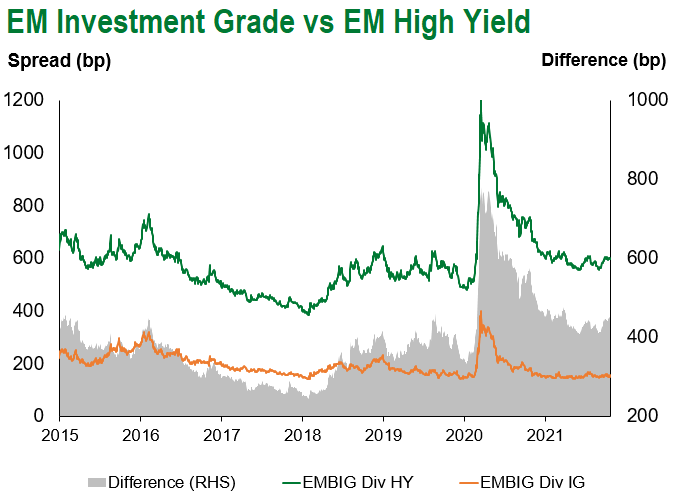
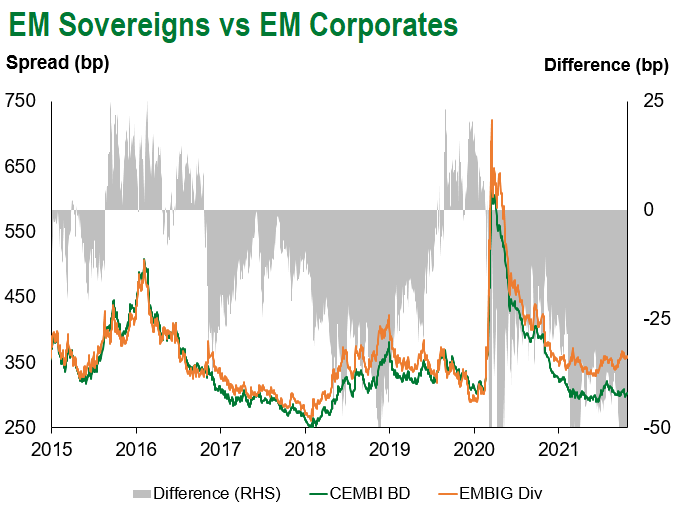
Emerging Markets Flows
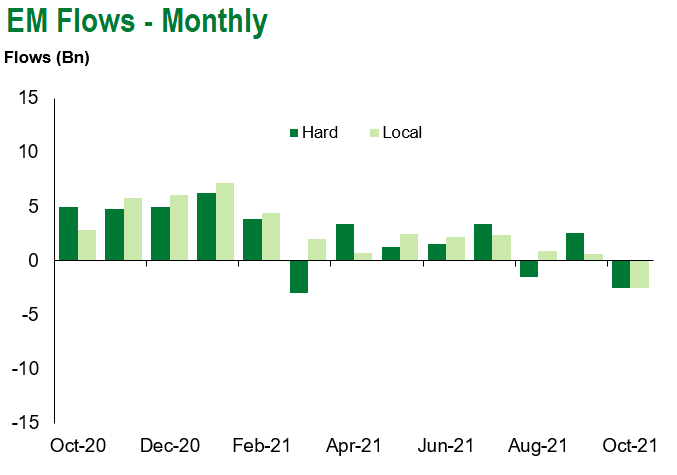
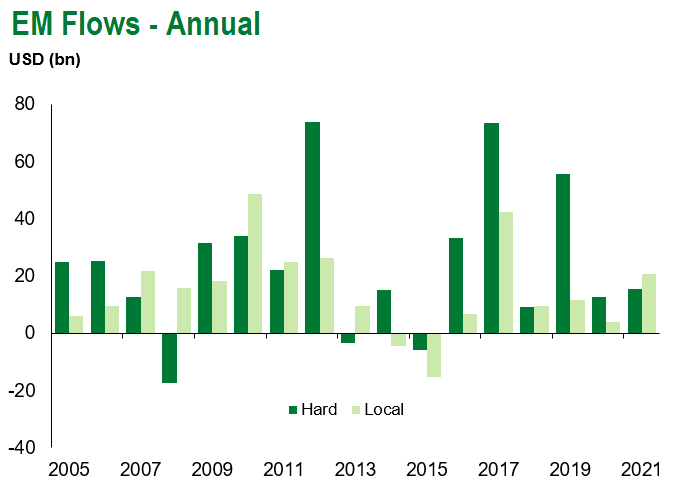
Source for graphs: Bloomberg, JPMorgan, Gramercy. As of October 29, 2021.
COVID Resources
Emerging Markets COVID-19 Case Summary
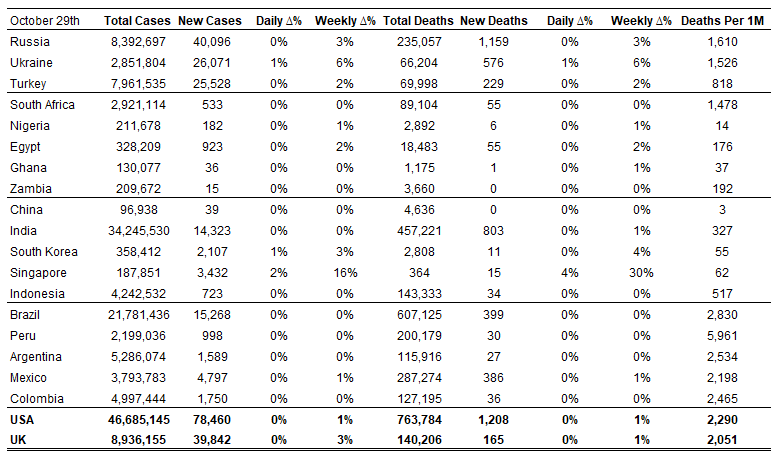
Source: Worldometer as of October 29, 2021.
Additional Crisis Resources:
Johns Hopkins COVID-19 Case Tracker
For questions, please contact:
Kathryn Exum, CFA ESG, Senior Vice President, Sovereign Research Analyst, [email protected]
Petar Atanasov, Senior Vice President, Sovereign Research Analyst, [email protected]
Tolu Alamutu, CFA, Senior Vice President, Corporate Research Analyst, [email protected]
James Barry, Vice President, Corporate Research Analyst, [email protected]
This document is for informational purposes only. The information presented is not intended to be relied upon as a forecast, research or investment advice, and is not a recommendation, offer or solicitation to buy or sell any securities or to adopt any investment strategy. Gramercy may have current investment positions in the securities or sovereigns mentioned above. The information and opinions contained in this paper are as of the date of initial publication, derived from proprietary and nonproprietary sources deemed by Gramercy to be reliable, are not necessarily all-inclusive and are not guaranteed as to accuracy. This paper may contain “forward-looking” information that is not purely historical in nature. Such information may include, among other things, projections and forecasts. There is no guarantee that any forecasts made will come to pass. Reliance upon information in this paper is at the sole discretion of the reader. You should not rely on this presentation as the basis upon which to make an investment decision. Investment involves risk. There can be no assurance that investment objectives will be achieved. Investors must be prepared to bear the risk of a total loss of their investment. These risks are often heightened for investments in emerging/developing markets or smaller capital markets. International investing involves risks, including risks related to foreign currency, limited liquidity, less government regulation, and the possibility of substantial volatility due to adverse political, economic or other developments. The information provided herein is neither tax nor legal advice. Investors should speak to their tax professional for specific information regarding their tax situation.